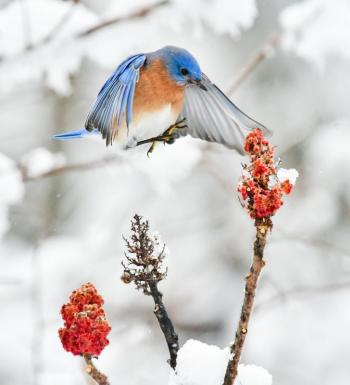Help Track Climate Impacts to Birds Through National Audubon’s Climate Watch
We heard on the news this morning that 2020 was the warmest year ever recorded in Portland, Maine. Across the state, we are seeing open water in rivers and lakes that we would have expected to be frozen solid from our experience in past years.
And as we mentioned in our column last week, Christmas Bird Counts in many parts of the state reported record numbers of a many bird species that have expanded northward into Maine over the last few decades. That includes species like tufted titmouse and red-bellied woodpecker, and in some areas Carolina wren and northern cardinal.
We remember well when eastern bluebirds were virtually unheard of as overwintering in the state. We saw several recently in Richmond, and a quick scan of eBird records shows perhaps a hundred or more observations of bluebirds across the southern half of the state since the beginning of December.
Numbers of most of our winter gulls, meanwhile, are on the decline. So are common goldeneyes, horned grebes, great cormorants, Canada jays, and boreal chickadees.
Climate change is already making profound changes to Maine’s environment and to our bird populations.
Many groups are working to slow the impact of climate change by pressing for government policies that decrease emissions of carbon pollution into the atmosphere. We hope all of you will find ways to help make that happen including through the efforts of the Natural Resources Council of Maine and the National Audubon Society.
Scientists also need volunteers to ground-truth the modelling analyses that are predicting how fast and how far different species of birds will shift their ranges as a result of climate change. One of the easiest and most enjoyable projects to assist this effort is National Audubon’s Climate Watch. All that is required is a few hours of time on one day in mid-winter and another in spring/summer to look for and count at least one target species in 12 spots in one general area. Of course, if one is so inclined you can also volunteer days or weeks of your time and do more.
The target species for Climate Watch include a number of birds we have here in Maine in winter including eastern bluebird, white-breasted and red-breasted nuthatch, and American goldfinch. One other target species—eastern towhee—can be found during summer.
To participate you pick a square on the map (there are very few participants so far here in Maine so probably the square where you live will not be taken) and then locate 12 spots within that square to do your counts. Each count is only five minutes long and you can focus on just one of the target species or more depending on your bird identification abilities. You do these counts on just one day during the period Jan 15-Feb 15 and one day during the period May 15-June 15.
Isn’t that an amazingly easy way to help figure out how bird populations are responding to climate change?
To learn more and sign up to participate go to: https://www.audubon.org/conservation/climate-watch.
Jeffrey V. Wells, Ph.D., is a Fellow of the Cornell Lab of Ornithology and Vice President of Boreal Conservation for National Audubon. Dr. Wells is one of the nation's leading bird experts and conservation biologists and author of the “Birder’s Conservation Handbook.” His grandfather, the late John Chase, was a columnist for the Boothbay Register for many years. Allison Childs Wells, formerly of the Cornell Lab of Ornithology, is a senior director at the Natural Resources Council of Maine, a nonprofit membership organization working statewide to protect the nature of Maine. Both are widely published natural history writers and are the authors of the popular book, “Maine’s Favorite Birds” (Tilbury House) and “Birds of Aruba, Bonaire, and Curaçao: A Site and Field Guide,” (Cornell University Press).


























